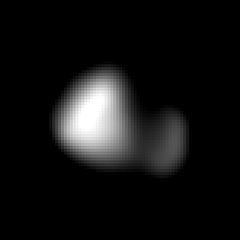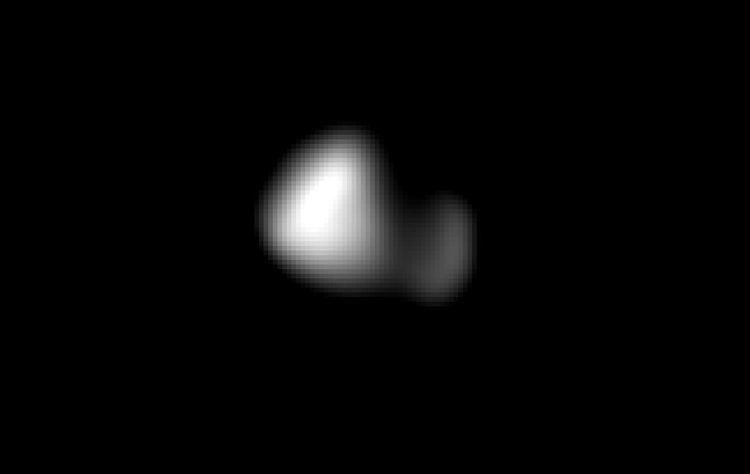Pronunciation /ˈkɜːrbərəs/ Eccentricity 0.00328 ± 0.00020 Discoverer Mark Showalter | Alternative names S/2011 P 1, P4 Discovered 28 June 2011 | |
 | ||
Discovered by Showalter, M. R. et al. Discovery date 28 June 2011(verified 20 July 2011) Semi-major axis 7007577830000000000♠57783±19 km Similar Mark Showalter discoveries, Pluto moons, Other celestial objects | ||
Kerberos is a small natural satellite of Pluto, about 12 km (7.5 mi) in its longest dimension. It was the fourth moon of Pluto to be discovered and its existence was announced on 20 July 2011. It was imaged, along with Pluto and its four other moons, by the New Horizons spacecraft in July 2015. The first image of Kerberos was released to the public on 22 October 2015.
Contents

Discovery

Kerberos was discovered by the Pluto Companion Search Team using the Hubble Space Telescope on 28 June 2011, using the Wide Field Camera 3, during an attempt to find any rings that Pluto might possess. Further observations were made on 3 and 18 July 2011 and Kerberos was verified as a new moon on 20 July 2011. It was later 'precovered' (identified in earlier archival Hubble images) in images from 15 February 2006 and 25 June 2010. Kerberos's brightness is only about 10% of that of Nix, and it was only found because the discovery team took 8-minute exposures; earlier observations had used shorter exposures.

The provisional designation of the satellite varied based on the source used. The International Astronomical Union announced it as S/2011 (134340) 1, whereas the New Horizons mission website announced it as S/2011 P 1.
Naming

Upon discovery, Kerberos received the minor planet designation S/2011 (134340) 1 because it was the first satellite (S) discovered orbiting minor planet (134340) in 2011. It was initially called "P4", meaning the fourth Plutonian moon to be discovered.
The convention for naming Plutonian moons is to use names associated with the god Pluto in classical mythology. To decide on names for P4 and P5, Mark Showalter and the SETI Institute, on behalf of the discovery team, conducted a non-binding Internet poll in 2013, in which the general public was invited to vote for their favorite names. The public could choose from a selection of Greek mythological names related to the god Pluto, or could propose their own names. After the initial announcement, William Shatner, the actor who played Captain James T. Kirk in the Star Trek franchise, proposed the names Vulcan and Romulus, ostensibly referring to the fire god Vulcan (a nephew of Pluto), and to Romulus the founder of Rome, but also alluding to the fictional planets of Vulcan and Romulus in the Star Trek universe. The 'Romulus' suggestion was discounted, because there is already an asteroid moon of that name, but Vulcan won the poll after Shatner tweeted about it, with Cerberus, (the dog that guards Pluto's underworld) coming second and Styx (the goddess of the river of the underworld) coming third. The winning names were submitted to the International Astronomical Union. However, 'Vulcan' was unacceptable to the IAU because it was not the name of an underworld deity and had already been used for a hypothetical planet inside the orbit of Mercury, as well as having given its name to the hypothetical vulcanoids. Cerberus is already the name of an asteroid, 1865 Cerberus, but the Greek form of the name, Kerberos, was acceptable to the IAU.
On 2 July 2013, the IAU announced that it formally approved the names Kerberos for P4 and Styx for P5.
Physical properties
Kerberos has a double-lobed shape and is approximately 7.4 mi (11.9 km) across in its long dimension and 2.8 mi (4.5 km) in its shortest dimension. Kerberos has an albedo similar to the other three small moons. Until the New Horizons flyby it was thought that Kerberos was larger and darker. Like the other small Plutonian satellites, Kerberos is not tidally locked; its current rotational period is about 5.33 days, although this varies quickly over geological timescales.
Orbit
Observations indicate a circular, equatorial orbit with a radius of approximately 58,000 km (36,000 mi). Kerberos orbits between Nix and Hydra and makes a complete orbit around Pluto roughly every 32.1 days. This period is close to a 1:5 orbital resonance with Charon, with the timing discrepancy being about 0.7%. As with the near resonances between Nix or Hydra and Charon (1:4 and 1:6, respectively), determining how close this relationship is to a true resonance will require more-accurate knowledge of Kerberos's orbit, in particular its rate of precession.
Origin
Like Pluto's other satellites, it is suspected that Kerberos coalesced from the debris of a massive collision between Pluto and another Kuiper belt object, similar to the giant impact thought to have created the Moon.
Exploration
The New Horizons spacecraft took images of Kerberos during its flyby of the Pluto system on 14 July 2015. Three months later, on 22 October, the first image of the moon was published. It is the last moon to have its picture released.
